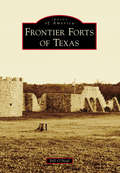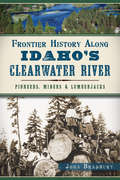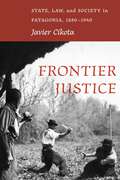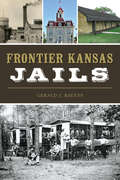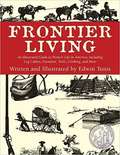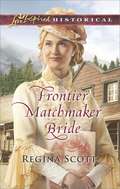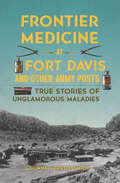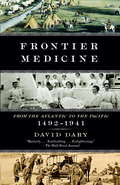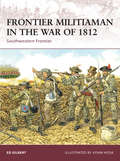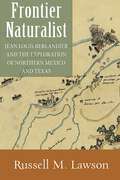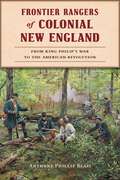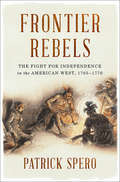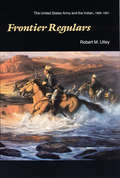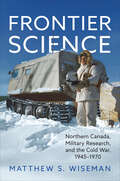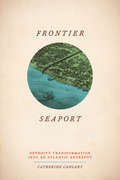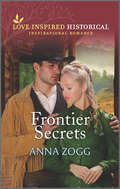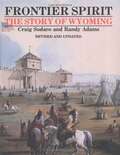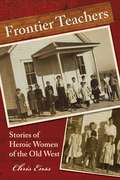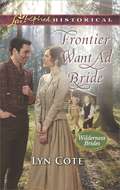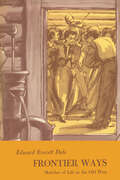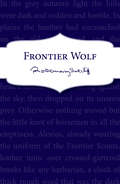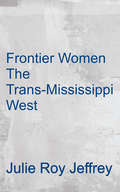- Table View
- List View
Frontier Forts of Texas (Images of America)
by Bill O'NealWith its vast size and long frontier period, Texas was the scene of more combat events between Native American warriors and Anglo soldiers and settlers than any other state or territory. The US Army, therefore, erected more military outposts in Texas, a tradition begun by Spanish soldados and their presidios. Settlers built blockhouses and even stockades, the most famous of which was Parker's Fort, the site of an infamous massacre in 1836. Successive north to south lines of Army forts attempted to screen westward-moving settlers from war parties, while border posts stretched along the Rio Grande from Fort Brown on the Gulf of Mexico to Fort Bliss at El Paso del Norte. Texas was the site of the first US Cavalry regiment employed against horseback warriors, as well as the experimental US Camel Corps. From Robert E. Lee to Albert Sidney Johnston to Ranald Mackenzie, the Army's finest officers served out of Texas forts, and 61 Medals of Honor were earned by soldiers campaigning in the Lone Star State.
Frontier History Along Idaho's Clearwater River: Pioneers, Miners & Lumberjacks
by John BradburyThe Clearwater River runs deep through northern Idaho's history. The Nez Perce tribe made its home along the river. Lewis and Clark's journey west took them through the Clearwater. In fact, the Nez Perce made the expedition's voyage from the Clearwater River to the Pacific Ocean possible by teaching them how to make dugout canoes from ponderosa pine logs. Fur traders like John Jacob Astor and William Ashley financed the first American commercial activity on the river, bringing trappers to the area and paving the way for the Oregon Trail. Later came the first gold rush, the Nez Perce war, statehood, homesteaders and the beginning of the logging industry. Join author John Bradbury as he recounts a time when native tribes, explorers, trappers, preachers, miners and lumberjacks made a life along the Clearwater, establishing the area for future generations.
Frontier Justice: State, Law, and Society in Patagonia, 1880–1940 (Path to Open)
by Javier CikotaFrontier Justice looks beyond the lawlessness and violence of frontiers to reveal instead the intricate tapestry of relationships that underpinned the development of civil society there. The book looks at northern Patagonia, which was military annexed to Argentina between 1878 and 1885. The Argentine government sought to develop in the region the kind of practices and institutions that would turn “barbarism” into “civilization.” Using court cases to reconstruct the partnerships between prominent neighbors and the police, among neighbors themselves, and between police, judges, and prosecutors, the book argues that settlers were active stakeholders in the establishment and continued functioning of the frontier state.The book centers on an unusual cast of frontier denizens, tackling issues of gender, race, patronage, and colonialism to better understand the competing sources of legitimacy in a newly incorporated area. By the time the national government finally sought to assert its presence more forcefully in the 1930s and 1940s, the population in northern Patagonia had developed its own “pioneer” political culture, built on patronage and informal legal arrangements and reliant on grassroots legitimacy.
Frontier Kansas Jails (Landmarks)
by Gerald J. BayensGunslingers, gamblers and outlaws vastly outnumbered sheriffs and marshals in the cattle towns of the Kansas frontier. Famous lawmen, such as Charlie Bassett, Wild Bill Hickok and Tom Smith, kept the peace by sheer force of personality and the integrity of the local lockup. The story of the state’s settlement can be tracked in the fascinating development of these bastions of prairie justice. Makeshift jails of earlier times were replaced by limestone, brick and concrete structures with iron cells and elaborate locking systems. From the squirrel cage of Wichita to the iron jail of Lawrence City, tour these early Kansas prisons with author Gerald Bayens.
Frontier Living
by Edwin TunisFrontier Living brings to light every significant aspect of daily life on the American frontier, with vivid text and more than 200 wonderful drawings. Immerse yourself in the character and culture of the men and women who stood at the harsh cutting-edge of our civilization: their dwellings, clothing, food, furniture, household articles; their hunting, farming, schooling, transportation, government; their amusements, superstitions, and religion.In Frontier Living the reader finds the forest frontiersman in his log cabin, the ranchero in his casa, the sodbuster in his prairie sod house. Here is the keel-boatman, the cotton farmer, the fur trader, the mountain man, the forty-niner, the cowhand - each helping to shape a new and distinctive way from untamed country. The flintlock gun, the Kentucky rifle, the freight and Conestoga wagons, the stagecoach, the Ohio flatboat, the first steamboat and steam railroad, are all reconstructed here in exact detail.This informative, authentic re-creation of the American frontier, seen in relation to its historic perspective, offers a major contribution toward an understanding of the American character. <P><P> Newberry Medal Honor Book
Frontier Matchmaker Bride: Frontier Matchmaker Bride The Amish Nanny's Sweetheart Accidental Family Husband By Arrangement (Frontier Bachelors Ser. #8)
by Regina ScottThe Lawman Meets His MatchSuccessful Seattle matchmaker Beth Wallin has her most challenging assignment yet—find Deputy Hart McCormick a bride. Beth’s still smarting after the handsome lawman spurned her affections a year ago. But if she finds Hart a wife, Beth will gain favor with the city’s most influential women…and perhaps free her own heart, as well.Marriage is the last thing on the deputy’s mind. After tragically losing his sweetheart, he vowed never to love again. But as sweet, spunky Beth introduces him to potential fiancées, Hart finally feels a spark…for her! The stubborn bachelor will be Beth’s first matchmaking miss, unless they can both admit that she just might be his perfect match.
Frontier Medicine at Fort Davis and Other Army Posts: True Stories of Unglamorous Maladies
by Donna Gerstle SmithFrom a headless burial to cocaine toothache drops, the true stories hidden in the Wild West's medical records are a match for its tallest tales.In the 19th century, when dying young was a fact of life, a routine bout of diarrhea could be fatal. No one had heard of viruses or bacteria, but they killed more soldiers on the frontier than hostile raiding parties. Physicians dispensed whiskey for TB, mercury for VD and arsenic for indigestion. Baseball injuries were considered to be in the line of duty and twice resulted in amputations at Fort Davis. Donna Gerstle Smith explains how an industrious laundress could earn more than a private, how a female army surgeon won the Medal of Honor and how a garrison illegally hung the local bartender.
Frontier Medicine: From the Atlantic to the Pacific, 1492-1941
by David DaryIn this intriguing narrative, David Dary charts how American medicine has evolved since 1492, when New World settlers first began combining European remedies with the traditional practices of the native populations. It's a story filled with colorful characters, from quacks and con artists to heroic healers and ingenious medicine men, and Dary tells it with an engaging style and an eye for the telling detail. Dary also charts the evolution of American medicine from these trial-and-error roots to its contemporary high-tech, high-cost pharmaceutical and medical industry. Packed with fascinating facts about our medical past,Frontier Medicineis an engaging and illuminating history of how our modern medical system came into being.
Frontier Militiaman in the War of 1812
by Adam Hook Ed Gilbert"He who relies on militia leans upon a broken cane." (George Washington)Osprey's survey of militiamen of the War of 1812. The great military effectiveness of semi-trained local militia is one of the enduring myths of American military history. In this book Ed Gilbert reveals the truth behind this myth. Quoting from memoirs of men like Sam Dale, Sam Houston, and rare histories, he sheds light on who these frontier men actually were. He chronicles how militiamen, ranging from hard-working farmers to politicians like Davy Crockett, were transformed through hard campaigning, fierce combat, and Andrew Jackson's equally fierce discipline, into a formidable fighting force. Contemporary illustrations and artwork depict the rough life on campaign and the uniforms worn by the militia. He details how they fought and won the crucial battle of Horseshoe Bend, and how finally on the swampy Plains of Chalmette a scratch force of State Militias, Federal Regulars, US Marines, and Jean Lafitte's mercenary pirates inflicted a stunning defeat on General Pakenham's forces, opening up the western frontier for the new nation.
Frontier Naturalist: Jean Louis Berlandier and the Exploration of Northern Mexico and Texas
by Russell M. LawsonThis is a true story of discovery and discoverers in what was the northern frontier region of Mexico in the years before the Mexican War. In 1826, when the story begins, the region was claimed by both Mexico and the United States. Neither country knew much about the lands crossed by such rivers as the Guadalupe, Brazos, Nueces, Trinity, and Rio Grande. Jean Louis Berlandier, a French naturalist, was part of a team sent out by the Mexican Boundary Commission to explore the area. His role was to collect specimens of flora and fauna and to record detailed observations of the landscapes and peoples through which the exploring party traveled. His observations, including sketches and paintings of plants, landmarks, and American Indians, were the first compendium of scientific observations of the region to be collected and eventually published.Here, historian Russell Lawson tells the story of this multinational expedition, using Berlandier&’s copious records as a way of conveying his view of the natural environment. Lawson&’s narrative allows us to peer over Berlandier&’s shoulder as he traveled and recorded his experiences. Berlandier and Lawson show us an America that no longer exists.
Frontier Rangers of Colonial New England: From King Philip's War to the American Revolution (Military)
by Anthony Phillip BlasiWarfare in the WildernessFew images reflect the character of hardy New Englanders like that of the eighteenth-century colonial ranger. Rugged characters such as Robert Rogers, Israel Putnam and John Stark spent much of their lives carving a living out of the harsh wilderness of the region, while later proving themselves in battle against seasoned Abenaki warriors. The Wright and Porter families fought throughout western New England, from skirmishes in Charlestown, New Hampshire, to climactic battles on Lake Champlain and Lake George. From the bloody King Philip’s War battlefields of Massachusetts to the fight for the wilderness of New Hampshire and Vermont, author Anthony Blasi explores the journey from frightened homesteader to toughened wilderness warrior.
Frontier Rebels: The Fight For Independence In The American West, 1765-1776
by Patrick SperoThe untold story of the “Black Boys,” a rebellion on the American frontier in 1765 that sparked the American Revolution. In 1763, the Seven Years’ War ended in a spectacular victory for the British. The French army agreed to leave North America, but many Native Americans, fearing that the British Empire would expand onto their lands and conquer them, refused to lay down their weapons. Under the leadership of a shrewd Ottawa warrior named Pontiac, they kept fighting for their freedom, capturing several British forts and devastating many of the westernmost colonial settlements. The British, battered from the costly war, needed to stop the violent attacks on their borderlands. Peace with Pontiac was their only option—if they could convince him to negotiate. Enter George Croghan, a wily trader-turned-diplomat with close ties to Native Americans. Under the wary eye of the British commander-in-chief, Croghan organized one of the largest peace offerings ever assembled and began a daring voyage into the interior of North America in search of Pontiac. Meanwhile, a ragtag group of frontiersmen set about stopping this peace deal in its tracks. Furious at the Empire for capitulating to Native groups, whom they considered their sworn enemies, and suspicious of Croghan’s intentions, these colonists turned Native American tactics of warfare on the British Empire. Dressing as Native Americans and smearing their faces in charcoal, these frontiersmen, known as the Black Boys, launched targeted assaults to destroy Croghan’s peace offering before it could be delivered. The outcome of these interwoven struggles would determine whose independence would prevail on the American frontier—whether freedom would be defined by the British, Native Americans, or colonial settlers. Drawing on largely forgotten manuscript sources from archives across North America, Patrick Spero recasts the familiar narrative of the American Revolution, moving the action from the Eastern Seaboard to the treacherous western frontier. In spellbinding detail, Frontier Rebels reveals an often-overlooked truth: the West played a crucial role in igniting the flame of American independence.
Frontier Regulars: The United States Army and the Indian, 1866-1891
by Robert M. UtleyIn Frontier Regulars Robert M. Utley combines scholarship and drama to produce an impressive history of the final, massive drive by the Regular Army to subdue and control the American Indians and open the West during the twenty-five years following the Civil War. Here are incisive accounts of the campaign directed by Major General William Tecumseh Sherman—from the first skirmishes with the Sioux over the Bozeman Trail defenses in 1866 to the final defeat and subjugation of the Northern Plains Indians in 1890. Utley's brilliant descriptions of military maneuvers and flaming battles are juxtaposed with a careful analysis of Sherman's army: its mode of operation, equipment, and recruitment; its lifestyle and relations with Congress and civilians.Proud of the United States Army and often sympathetic toward the Indians, Utley presents a balanced overview of the long struggle. He concludes that the frontier army was not "the heroic vanguard of civilization" as sometimes claimed and still less "the barbaric band of butchers depicted in the humanitarian literature of the nineteenth century and the atonement literature of the twentieth." Rather, it was a group of ordinary (and sometimes extraordinary) men doing the best they could.
Frontier Science: Northern Canada, Military Research, and the Cold War, 1945–1970
by Matthew WisemanBetween 1945 and 1970, Canada’s Department of National Defence sponsored scientific research into the myriad challenges of military operations in cold regions. To understand and overcome the impediments of the country’s cold climate, scientists studied cold-weather acclimatization, hypothermia, frostbite, and psychological morale for soldiers assigned to active duty in northern Canada. Frontier Science investigates the history of military science in northern Canada during this period of the Cold War, highlighting the consequences of government-funded research for humans and nature alike. The book reveals how under the guise of “environmental protection” research, the Canadian military sprayed pesticides to clear bushed areas, used radioactive substances to investigate vector-borne diseases, pursued race-based theories of cold tolerance, and enabled wide-ranging tests of newly developed weapons and equipment. In arguing that military research in northern Canada was a product of the Cold War, Matthew S. Wiseman tackles questions of government power, scientific authority, and medical and environmental research ethics. Based on a long and deep pursuit of declassified records, archival sources, and oral testimony, Frontier Science is a fascinating new history of military approaches to the human-nature relationship.
Frontier Seaport: Detroit's Transformation into an Atlantic Entrepôt (American Beginnings, 1500-1900 Ser.)
by Catherine CanganyDetroit’s industrial health has long been crucial to the American economy. Today’s troubles notwithstanding, Detroit has experienced multiple periods of prosperity, particularly in the second half of the eighteenth century, when the city was the center of the thriving fur trade. Its proximity to the West as well as its access to the Great Lakes and the St. Lawrence River positioned this new metropolis at the intersection of the fur-rich frontier and the Atlantic trade routes. In Frontier Seaport, Catherine Cangany details this seldom-discussed chapter of Detroit’s history. She argues that by the time of the American Revolution, Detroit functioned much like a coastal town as a result of the prosperous fur trade, serving as a critical link in a commercial chain that stretched all the way to Russia and China—thus opening Detroit’s shores for eastern merchants and other transplants. This influx of newcomers brought its own transatlantic networks and fed residents’ desires for popular culture and manufactured merchandise. Detroit began to be both a frontier town and seaport city—a mixed identity, Cangany argues, that hindered it from becoming a thoroughly “American” metropolis.
Frontier Secrets
by Anna ZoggA woman seeking a new future.A cowboy with a shadowed past.Untamed Wyoming is nothing like polished, restrictive Chicago—that’s why Ellie Marshall likes it. On her uncle’s ranch, she’s free. Free to practice her calling in medicine. Free to finally connect with her uncle. Free to explore her feelings for mysterious cowboy Rhett Callaway. In this strange place, Rhett is her constant—the one she trusts to help and protect her…especially when sinister machinations on the ranch come to light. But will Rhett’s murky past drive him away just when Ellie needs him most?
Frontier Socialism: Self-Organisation and Anti-Capitalism (Marx, Engels, and Marxisms)
by Monica Quirico Gianfranco RagonaConsidering the history of workers' and socialist movements in Europe, Frontier Socialism focuses on unconventional forms of anti-capitalist thought, particularly by examining several militant-intellectuals whose legacy is of particular interest for those aiming for a radical critique of capitalism. Following on the work of Michael Löwy, Quirico & Ragona identify relationships of “elective affinity” between figures who might appear different and dissimilar, at least at first glance: the German Anarchist Gustav Landauer, the Bolshevik Alexandra Kollontai, the German communist Paul Mattick, the Italian Socialist Raniero Panzieri, the Greek-born French euro-communist Nikos Poulantzas, the German-born Swedish Social Democrat Rudolf Meidner, and the French social scientist Alain Bihr as well as two historical struggle experiences, the Spanish Republic and the Italian revolutionary group “Lotta continua”. Frontier Socialism then analyzes these thinkers' and experiences’ respective paths to socialism based on and achieved through self-organization and self-government, not to build a new tradition but to suggest a path forward for both research and political activism.
Frontier Spirit: The Story of Wyoming (Revised and Updated)
by Randy Adams Craig SodaroWyoming has one of the most exciting histories of any western state. Authors Craig Sodaro and Randy Adams are born story-tellers who exemplify the maxim that good history is never dull. From prehistory through the Indian wars, from the wild years of territorial Wyoming up to the conflicts and coming of age in the twentieth century, Wyoming's past comes to life in these pages. The emphasis of the book is on the people of Wyoming, how they lived and what they lived for, how events outside the state affected them, and how they affected the rest of the world. The authors expertly draw connections among seemingly widely separated events to illuminate the seamlessness of history's web. By developing a deeper understanding of the past, the reader comes away with a greater sense of the state's identity today. The title, "Frontier Spirit," was not chosen lightly; probably more than any other state in the lower forty-eight, Wyoming still typifies that spirit. This book shows why.
Frontier Teachers: Stories of Heroic Women of the Old West
by Chris EnssFrontier Teachers tells the stories of a dozen courageous, intrepid women who faced down rooms full of children on the open prairies and in the mining towns of the Old West to bring them educational opportunities.
Frontier Want Ad Bride
by Lyn CoteBride by Mail Mail-order bride Judith Jones has barely arrived in Pepin, Wisconsin, before she's whisked away to prepare for her wedding to Asa Brant. Though something about Asa seems so familiar, how do two strangers become husband and wife? Especially when Judith senses Asa's hidden sorrow. His kindness in helping two young orphans could win her heart...if only he'd open up to her. Determined to start over after four years of brutal war, Asa moved away and sent for a mail-order bride. He had no idea the woman answering his ad would be the sister of his former soldier in arms. The less he reveals, the fewer painful memories there are to confront. But Judith's compassion-and two loving children-might just show them the path to true happiness...
Frontier Ways: Sketches of Life in the Old West (Personal Narratives of the West)
by Edward Everett DaleEdward Everett Dale gives a first-hand account of the way pioneer families and cowboys of the frontier lived. Dale has lived in a sod house, and he once rode the range as cook to a group of cowboys. In this book he draws on his varied experiences to describe all aspects of frontier life—the building of a home, the problems of finding wood and water, the procuring and cooking of food, medical practices, and the cultural, social, and religious life of pioneer families.
Frontier Ways: Sketches of Life in the Old West (Personal Narratives of the West)
by Edward Everett DaleThe classic account of what day-to-day life was like for cowboys and pioneer families in the American West. Born in a log cabin in 1879—Edward Everett Dale sought education and become a prolific and versatile professional writer—but always remained rooted in his close connection to the frontier. He lived in a sod house, and once rode the range as cook to a group of cowboys. His life experiences brought exceptional authenticity to his work, including this classic first-hand account of the way pioneers lived. In Frontier Ways he describes all aspects of frontier life: the building of a home, the problems of finding wood and water, the procuring and cooking of food, medical practices, and the cultural, social, and religious life of pioneer families. Lively and involving, this collection of his essays has allowed generations of readers to look back on the West&’s fascinating past. &“At times [Dale] was the serious scholarly research-bent historian, but more often he was the folklorist, humorist, on-the-spot frontier reporter.&” —Great Plains Journal
Frontier Wolf
by Rosemary SutcliffAs punishment for his poor judgment, a young, inexperienced Roman army officer is sent to Northern England to assume the command of a motley group known as the Frontier Wolves.
Frontier Wolf
by Rosemary Sutcliff'We are the scum and the scrapings of the Empire. They tipped out the garbage-bin of the Eagles to make us what we are.'In disgrace after a mistake that cost the lives of half his men, Alexios arrives in Castellum. It's his first command, but it isn't really a promotion. The Frontier Wolves who man this outpost in the far north of Roman Britain are a fierce and savage bunch, a far cry from the regular legions he'd served in before. Alexios will only survive if he learns to understand them and win their respect - and he's determined to try.
Frontier Women: The Trans-Mississippi West (American Century)
by Julie R. JeffreyFrontier Women The Trans-Mississippi West 1840-1880
